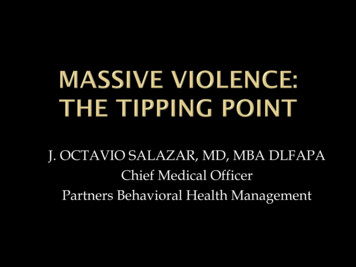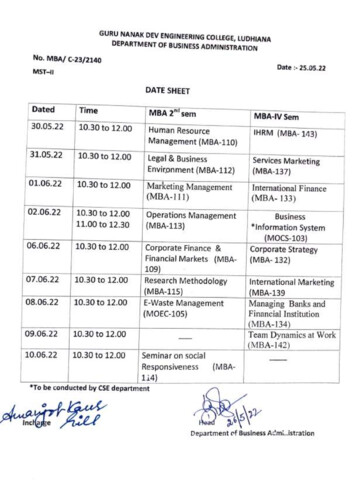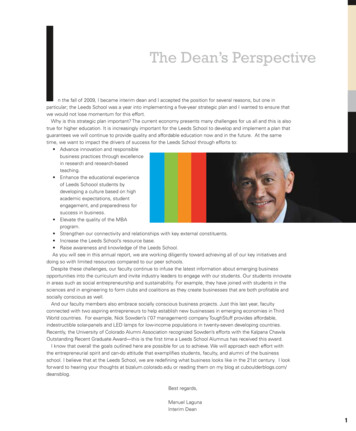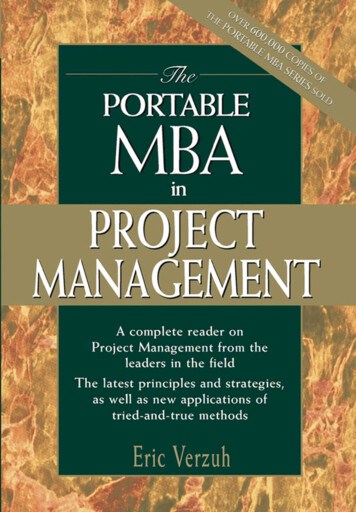
Transcription
J. OCTAVIO SALAZAR, MD, MBA DLFAPAChief Medical OfficerPartners Behavioral Health Management
The intentional and indiscriminate murder oflarge number of people by government agentsDeliberate massacres of captives or civiliansduring war time by the state’s military forcesActions in which the state or terrorist groupscaused the death of large numbers of peoplefor political motivationPolitical implications of gun control or mentalillness
From 1982 to 2013, 70 mass shootings tookplace across the countryKillings took place in 30 states fromMassachusetts to Hawaii33 of these mass shootings have occurred since20067 of these events took place in 2012, 5 in 2013More than half of the cases involve schoolshootings or work place
44 of the killers where white malesOnly one was a woman.The average age of the killer was 35, theyoungest was 11 years oldThe majority were mentally troubled
Exposure to violence is a national crisis thataffects two out of every three of our children.Of 76 M children currently residing in the US,an estimated 46 M can expect to have their livestouched by violence, crime, abuse andpsychological trauma this year.Violence occurs in children’s homes,neighborhoods, schools, playgrounds orplaying fields, locker rooms, places of worship,shelters, streets, or in juvenile detentioncenters (Attorney General’s National task force on children exposed toviolence)
In 2000, an estimated 199,000 youth homicides (9.2 per100, 000 population) occurred globally, in other words 565children adolescents and young adults between the agesof 10 and 29 years die each day as a result of interpersonalviolenceHomicide rate:0.9 per 100,000 in the high income countries of Europe,parts of Asia and the Pacific17.6 per 100,000 in Africa36.4 per 100,000 in Latin AmericaYouth homicides are substantially lower among femalesthan among males
Exposure to violence in any form harmschildren, and different forms of violence havedifferent negative impactSexual abuse: Serious and chronic healthproblems including PTSD, depression, suicidePhysical abuse: Cognitive, developmental andpsychological consequencesIntimate partner violence: Life long problemswith physical, mental health, school, peersCommunity violence: Witnessing assaults andkillings. Belief: Violence is normal
There are close links between youthviolence and other forms of violenceWitnessing violence in the homeBeing physically or sexually abusedProlonged exposure to armedconflict
Understanding the factors thatincrease the risk of young peoplebeing the victims or perpetrators ofviolence is essential for developingeffective policies and programs toprevent violence
It can develop in different ways: Some children gradual increase intoadolescence 20% - 45% of boys, 47%-69% of girls: Lifecourse persistent developmentalpathway. They often commit the mostserious violent acts and often continuetheir violent behavior into adulthood
Longitudinal studies have shown thatchildhood aggression is a good predictor ofviolence in adolescence and early adulthood.Study: Orebro (Sweden): two thirds of thesample of around 1000 young males whodisplayed violent behavior up to the age of 26years had already scored highly foraggressiveness at the ages of 10 and 13 years.Study in Finland 400 youths, ratings by peersof aggression at 8 and 14 years significantlypredicted violence up to the age of 20
Youth violence cannot be seen in isolation fromother problems or behaviorsViolent young people tend to commit a rangeof crimes, they often display truancy, droppingout of school, substance abuse, compulsivelying, reckless driving and high rates ofsexually transmitted diseasesNot all violent youths have significantproblems other than their violence.Not all young people with problems are violent
Study in Columbus OH:59% of youth arrested for violentoffences before the age of 18 wererearrested as adults42% were charged with at least oneserious violent offence such ashomicide, aggravated assault or rape
INDIVIDUAL FACTORSBiologicalPsychologicalSocialFAMILY FACTORSSITUATIONAL FACTORS
Factors associated with and contributing tomass murder are complex and multideterminedBiological factors may include brain pathology,as well as psychiatric illness.Psychological factors include a negative orfragile self-image, a strong sense of entitlementand vulnerability to humiliationSocial factors include socialisolation/alienation, being bullied, and maritalor financial loss
Injuries and complications associated withpregnancy and delivery: Neurological damage?Study in Denmark: 200 children born 1959 and1961. Complications during delivery were apredictor for arrest for violence up to age 22.80% of youth arrested for committing violentoffences scored in the high range for deliverycomplications compared to those arrested forcommitting property related offences .Pregnancy complications on the other hand didnot significantly predict violence
Delivery complications were strongly associatedwith future violence when a parent had a historyof psychiatric illness.In this cases, 32 % of males with significantdelivery complications were arrested for violence,compared with 5% of those with only minor or nodelivery complicationsOther studies have not replicated these findingsLow heart rates are associated with sensationseeking and risk taking both may predispose toaggression and violence
Impulsivity, attention problems, low intelligenceand low educational attainment may all be linkedto deficiencies in the executive functions of thebrain, located in the frontal lobes.These executive functions include: Sustainingattention and concentration, abstract reasoning,and concept formation, goal formulation,anticipation and planning, effective selfmonitoring and self-awareness of behavior andinhibition regarding inappropriate or impulsivebehaviors
Major personality and behavioral factors that maypredict youth violence are Hyperactivity,Impulsivity and poor behavioral control andattention problemsNervousness and anxiety are negatively related toviolenceNew Zealand: 1000 boys with violent convictionsup to the age of 18 were significantly more likelyto have had poor scores in behavioral control atage 3-5 compared with boys with no convictions orconvictions for non violent offences
Longitudinal studies in Denmark, Sweden,England and Pittsburgh, USA showed linksbetween those personality factors before age20. They were convicted again between theages of 21 – 40 compared to only 8% of thosenot convicted for violent offences during theirteenage years
The existence of a life-course persistentdevelopmental pathway helps to explain thecontinuity over time in aggressive and violentbehavior.There are certain individuals who persist inhaving a greater underlying tendency thanothers towards aggressive or violent behavior.Those who are relatively more aggressive at agiven age also tend to be relatively moreaggressive later on, even though their absolutelevels of violence may vary.
Life time offenders, though, represent only a smallproportion of those committing violence.Most violent young people engage in violentbehaviors over much shorter periods. Such peoplearte termed “adolescent limited offenders”Studies have shown that a small proportion ofyouth continue to commit violence into andthrough adulthood. Some three quarters of youngpeople who had committed serious violenceceased their violent behavior after around 1- 3years
SEVERE ANGERPOOR ANGER MANAGEMENTINABILITY TO EXPRESS ANGERAPPROPRIATELYANGER AND RESENTMENT
LOW SELF ESTEEMFEELINGS OF INADEQUACY AND FAILUREPOWERLESNESSFEELING THAT NOBODY PAYSATTENTION TO THEM OR NOTICES THEM
WARNING SIGNS: ANGER – ISOLATION SHYBEING PICKED ON BY PEERS, BEINGREJECTED.FEELING RESENTFUL AND WITH WISHESFOR REVANCHEWANTING TO BE FAMOUS AND TO BE ONTV
FEELING THAT NOBODY UNDERSTANDSTHEM OR LIKES THEMWANTING TO BE IMPORTANT, TO BENOTICEDSEEKING ATTENTION, WANTING TO BENOTICED AND THEY END UP GETTINGATTENTION IN THE NEGATIVE WAY
Violence in adolescence and adulthood has alsobeen strongly linked to parental conflict inearly childhood and poor attachment betweenparents and childrenOther factors may include : A large number ofchildren in the family, a mother who had herfirst child at early age, possibly as a teenagerand a low level of family cohesionChildren growing up in a single parenthouseholds are at greater risk for violence
Parental behaviors and family environment arecentral factors in the development of violentbehavior in young people.Poor monitoring and supervision, use of harshphysical punishment are strong predictors ofviolence during adolescence and adulthood.Study in Boston, MA, 250 boys: Poor parentalsupervision, parental aggression and harshdiscipline at age 10 strongly increased the riskof later conviction for violence up to age 45.
These Factors Include The motives for violent behavior Where the behavior occurs Whether alcohol or weapons are present Whether people other than the victim andoffender are present Whether other actions (such as burglary) areinvolved that could be conducive to violence
The answer is “it depends” upon the mind ofthe individual perpetrator and the accumulatedbio-psychosocial factors that affected himThe majority of research indicates that there arefactors common to mass murderers:Extreme feelings of anger and revenge, lack ofan accomplice, feelings of social isolation, andplanning/organizing the offense
A detailed case study of 5 mass murderers whowere caught before they were killed show thefollowing common traits and historical factors: The subjects had all been bullied or isolated aschildren, turning into loners who felt despairover being socially excluded They were described as suspicious, resentful,grudge-holders who demonstrated obsessiveand inflexible thinking Their worldview was characterized by seeingothers as rejecting and uncaring
They spent great deal of time nurturing theirresentment and ruminating on pasthumiliations. The ruminations evolved intofantasies of violent revenge. They did not seetheir own violent death as a deterrent,particularly because they perceived it asbringing them fame with an aura of powerCases often reveal that the offender feltcompelled to leave some type of final messagethat may be written, videotaped or posted onthe internet or social media
Community shootings do not involve aprimary target or institution. The shootingmay begin with someone the killer feelsprovoked him, or is symbolic of someperceived grudge. However, community massshootings reflect someone with a substantialdegree of paranoia and more generalresentment toward the outside world. Theparanoia may be a general suspiciousness andcontempt of others or a full – blown delusionalthinking.
In community shootings the killer has a poorlyintegrated identity, whether he is adolescent oradult. An angry and destructive fantasygraduates into a righteous cause that gives akiller the notion of greatness throughdestruction. By making a violent and dramaticstatement about his grudge, or his grievance, orothers he claims to represent he is empowered.
Mass shooters are frequently experienced byothers as calm. This incongruous serenityspeaks more to how dysfunctionally theyexpress their anger.
Community mass shootings show the actualevent being out of proportion to the trigger thatsets it off. The killer is someone that hasnurtured a homicidal plan for some time,somewhat vaguely. The idea intensifies withdespair. If there is a certain despair or sense ofloss, which may have nothing to do with thekilling itself, even a seemingly minor triggerwill set the homicidal fantasy into motion.
No single warning sign can predict that adangerous act will occur.Imminent warning signs usually are presented as asequence of overt, serious, hostile behaviors orthreats directed at peers, staff, or other individuals.Usually, imminent warning signs are evident tomore than one staff member as well as to thechild’s family.
SOCIAL WITHDRAWALEXCESSIVE FEELINGS OF ISOLATION AND BEING ALONEEXCESSIVE FEELINGS OF REJECTIONBEING A VICTIM OF VIOLENCEFEELINGS OF BEING PICKED ON AND PERSECUTEDLOW SCHOOL INTEREST AND POOR ACADEMICPERFORMANCEEXPRESSION OF VIOLENCE IN WRITINGS AND DRAWINGSUNCONTROLLED ANGERPATTERNS OF IMPULSIVE AND CHRONIC HITTING,INTIMIDATING, AND BULLYING BEHAVIORSPAST HISTORY OF VIOLENT AND AGGRESSIVE BEHAVIORDRUG AND/OR ALCOHOL USESERIOUS THREATS OF VIOLENCE
Serious physical fighting with peers or familymembers.Severe destruction of propertySevere rage for seemingly minor reasonsDetailed threats of lethal violencePossession and /or use of firearms and otherweaponsOther self-injurious behaviors or threats ofsuicide
STATEMENTS: I AM GOING TO DO SOMETHING THATWILL BE REMEMBERED FOR MANY YEARS. I WILL DO SOMETHING THAT EVERYBODYWILL HEAR ABOUT I WILL MAKE IT A MEMORABLE DAY I WILL KILL THE PEOPLE I AM ANGRY AT
Bolivar, MO, narrowly avoided becoming the nextAurora. How? The mother of a potential massmurderer contacted the police because she wasworried that her son had intentions of shootingpeople during the opening of the final film in thepopular Twilight vampire movie series.Predictably, the mother was right to be concerned.When her son was questioned by police, he saidthat he had already bought tickets and “planned”to shoot people inside the theater. Police foundthat he did have the weapons, he did have theammunition and then he made the statements tothe officer about what his plans were
Another example:Andrew Behring Breivik on July 22, 2011 killedmore than 70 innocent people in Oslo. Breivik’ssister had been concerned enough to warn hermother at least 2 years prior to the tragedy.Mass murder is carried out by a single, heavilyarmed individual who is very likely to expectto die as a result of the event.
Third parties, particularly family members arethe most likely to have pre offense knowledgeor significant concerns.Potential mass murderers often “leak theirintent” to third parties, who in turn, remainquiet for several reasons.The silence of third parties seals the fate of boththeir loved ones and scores of innocent people.
Not all mass murderers are alike in theirmotivation and psychology.Some may be driven by strong feelings ofrevenge born of social alienation or perceivedinjusticeOthers may also suffer from severe depression,or rarely, psychosisOthers may resemble terrorists withidiosyncratic political beliefs
A notable motivation for mass murder isrevenge but other motivations are possible,including the need for attention or fame
Are alienated loners responsible for massshootings? Is that all there is?There are many alienated loners. Most don’tkill. Conversely, mass shooters would not killwere they not to be so isolated or so alienated.Depending on the setting or the target, thereare specific key ingredients to their personality,mood, life stage, triggers to the event, andsense of identity that combine, in the alienatedloner, to a homicidal end.
MOTIVATION: WANTING TO BE NOTICED WANTING TO FEEL IMPORTANT WANTING TO BE ON TV AND BEINGFAMOUS REVANGE
When warning signs indicate that danger isimminent, safety must always be the first andforemost consideration. Action must be takenimmediately. Immediate intervention by schoolauthorities and possibly law enforcement officersis needed when a child:Has presented a detailed plan (time, place,method) to harm or kill others-particularly if thechild has a history of aggression and or hasattempted to carry out threats in the past.Is carrying a weapon, particularly a firearm, andhas threatened to use it.
Unlike early warning signs, imminent warningsigns indicate that a student is very close tobehaving in a way that is potentially dangerous toself/or to others. Imminent warning signs requirean immediate response.
In situations where students present otherthreatening behaviors, parents should be informedof the concerns immediately. Schools communitiesalso have the responsibility to seek assistance fromappropriate agencies, such as child and familyservices and community mental health. Theseresponses should reflect school board policies andbe consistent with violence prevention andresponse plan.
Average response time by police to a massshooting is typically much longer than the time theshooter is engaged in killing. While immediateaction may be extremely dangerous, it may savelives which would be lost if people involved in thesituation remain passive, or a police response isdelayed until overwhelming force can bedeployed. It is recommended that civiliansinvolved in the incident take active steps to flee,hide, or fight the shooter and that individual lawenforcement officers present or first arriving at thescene attempt immediately to engage the shooter.This action may save lives.
Early intervention is critical. Parents, teachers andmental health professionals can do a great deal tohelp these youngsters recover.Help should begin at the scene of the traumaticevent:1. Find ways to protect children from further harmand from further exposure to traumatic stimuli. Ifpossible, create a safe heaven for them. Protectchildren from onlookers and the media coveringthe story.
2. When possible, direct children who are able towalk away from the site of violence or destruction,away from severely injured survivors, and awayfrom continuing danger. Kind but firm direction isneeded3. Identify children in acute distress and stay withthem until initial stabilization occurs. Acutedistress includes panic (marked by trembling,agitation, rambling speech, becoming mute, orerratic behavior) and intense grief (signs includeloud crying, rage, or immobility)
4. Use supportive and compassionate verbal ornon-verbal exchange (such as a hug, ifappropriate) with the child to help him or her feelsafe. However brief the exchange, or howevertemporary, such reassurances are important tochildren.5. After violence or disaster occurs, the family isthe first-line resource for helping.
Develop programs to address not onlyindividual cognitive, social and behavioralfactors but also the social systems that shapethese factorsAdoption of preschool enrichment programs:Strengthen a child’s bonds to the school andraise achievement and self esteem.Programs improving competency and socialskills with peers, promoting behavior that ispositive, friendly and cooperative
Other programs Relationship approaches Home visitation by a nurse or other health careprofessional Training in parenting Mentoring programs: Role modeling Therapeutic approaches
Research has shown that violent or aggressivebehavior is often learned in early life. However,parents, family members, and others who carefor children can help them learn to deal withemotions without using violence. Parents andothers can also take steps to reduce orminimize violence.
1. Some studies show that counseling childrenvery soon after a catastrophic event may reducesome of the symptoms of PTSD.2. Parent’s response to a violent event or disasterstrongly influences their children’s ability torecover. This is particularly true for mothers ofyoung children. If the mother is depressed orhighly anxious, she may need to get emotionalsupport or counseling in order to be able to helpher child.
1. If possible give yourself a bit of time to come toterms with the event before you attempt toreassure the children. This may not be possible incase a violent episode that occurs at school, butsometimes in a natural disaster there will beseveral days before school reopen and teachers cantake the time to prepare themselves emotionally.
2. Don’t try to rush back to ordinary schoolroutine too soon. Give the children or adolescentstime to talk over the traumatic event and expresstheir feelings about it.3. Respect the preferences of children who do notwant to participate in class discussions about thetraumatic event. Do not force discussion orrepeatedly bring up the catastrophic event; doingso may re-traumatize children.
4. Hold in-school sessions with entire classes, withsmaller groups of students, or with individualstudents. These sessions can be very useful inletting students know that their fears and concernsare normal reactions. Many counties and schooldistricts have teams that will go into schools tohold such sessions after a disaster or episode ofviolence.5. Offer art and play therapy for children inprimary school.
6. Hold meetings for parents to discuss thetraumatic event, their children’s response to it, andhow they and you can help. Involve mental healthprofessionals in these meetings if possible.
1. Explain the episode of violence or disaster as wellas you are able.Encourage children to express their feelings and listenwithout passing judgment.2. Help younger children learn to use words thatexpress their feelings. However do not forcediscussion of the traumatic event.3. Let children and adolescents know that it is normalto feel upset after something bad happens.
4. Allow time for the youngsters to experience andtalk about their feelings. At home, however, a return toroutine can be reassuring to the child.5. If your children are fearful, reassure them that youlove them and will take care of them. Stay together asa family as much as possible.6. If behavior at bedtime is a problem, give the childextra time and reassurance. Let him or her sleep with alight on or in your room for a limited time if necessary.
7. Reassure children and adolescents that thetraumatic event was not their fault.8. Do not criticize regressive behavior or shame thechild with words like “babyish”9. Allow children to cry or to be sad. Don’t expectthem to be brave or tough
10 Encourage children and adolescents to feel incontrol. Let them make some decisions aboutmeals, what to wear, etc.11 Take care of yourself so you can take care of thechildren.
childhood aggression is a good predictor of violence in adolescence and early adulthood. Study: Orebro (Sweden): two thirds of the sample of around 1000 young males who displayed violent behavior up to the age of 26 years had already scored highly for aggressiveness at the ages of 10 and 13 years. Study in Finland 400 youths, ratings by peers










